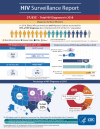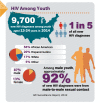The ongoing HIV epidemic in American youth: challenges and opportunities
- PMID: 33898602
- PMCID: PMC8063015
- DOI: 10.21037/mhealth-20-42
The ongoing HIV epidemic in American youth: challenges and opportunities
Abstract
The incidence of human immunodeficiency virus (HIV) infection has been decreasing in the United States overall, except among youth, and in particular among Black and Latinx young men who have sex with men (MSM). In this review we summarize key drivers of the HIV epidemic among youth, as well as novel interventions geared specifically towards combating the epidemic among high-risk populations. Many factors driving the HIV epidemic among youth are related to systemic inequities, including lack of access to healthcare, inadequate education, and internalized and experience homophobia and racism. Developmentally, youth may feel that they are invulnerable and be willing to engage in risks. Moreover, HIV is often invisible for youth given advances in treatment and community stigma, limiting open discussion of risk and new preventive modalities. Outcomes from the HIV treatment cascade suggest that youth are less likely to be aware of their HIV infection status, less likely to link to and be engaged in care, and less likely to be virologically suppressed than older MSM and other populations of people living with HIV. Importantly, pre-exposure prophylaxis (PrEP) has been shown to be an effective tool for prevention of HIV infection that also appears to have disproportionately poor uptake among youth. Barriers to PrEP utilization appear to be quite heterogeneous, and include patient-, provider-, and structural-level barriers. Interventions important in improving HIV prevention will thus have to be multipronged and developed for culturally diverse populations. Cognitive behavioral therapy-based interventions are promising strategies as they are able to address a diverse array of barriers. New formulations of PrEP will also likely be instrumental in improving adherence. Since youth spend considerable amounts of time accessing digital media, the deployment of apps and other mobile phone-based interfaces offer unique opportunities to increase education and to facilitate HIV prevention for at risk youth. Multiple studies are underway to better inform the optimal delivery of treatment and prevention services for this complex and diverse population, and include novel sociobiological interventions and new modes of medication delivery that may lend themselves to overcoming obstacles specific to youth.
Keywords: Human immunodeficiency virus (HIV); MSM; United States; pre-exposure prophylaxis (PrEP); youth.
2021 mHealth. All rights reserved.
Conflict of interest statement
Conflicts of Interest: All authors have completed the ICMJE uniform disclosure form (available at http://dx.doi.org/10.21037/mhealth-20-42). The series “Technology-based Interventions in HIV Prevention and Care Continuum among American Youth” was commissioned by the editorial office without any funding or sponsorship. LM has received grants and personal fees from Gilead Science, ViiV Healthcare, from Merck, and Roche Molecular, grants from Binx Health, Evofem Inc., Click Diagnostics, Janssen Pharmaceutical, Prosoft Clinical, GSK, and SpeedDx Pty Ltd, outside the submitted work; KM has received unrestricted research grants to study antiretrovirals for prevention from Gilead Science, Merck, and ViiV Healthcare, and HIV vaccines with Janssen, outside the submitted work. The authors have no other conflicts of interest to declare.
Figures



References
-
- Centers for Disease Control and Prevention. HIV Surveillance Report, 2016; vol 28. HIVSurveillance Report: Diagnoses of HIV Infection in the United States and Dependent Areas,2016. Centers for Disease Control and Prevention website. Available online: http://www.cdc.gov/hiv/library/reports/hiv-surveillance.html. Published November 2017. Accessed August 7th 2019.
-
- World Health Organization. HIV/AIDS Data and Statistics. Updated 2019. Available online: https://www.who.int/hiv/data/en/. Accessed August 7th, 2018.
-
- Centers for Disease Control and Prevention. Monitoring selected national HIV prevention and care objectives by using HIV surveillance data - United States and 6 dependent areas, 2014. HIV Surveillance Supplemental Report 2016;21(No. 4). Available online: http://www.cdc.gov/hiv/library/reports/surveillance/. Published July 2016. Accessed August 7th 2019.
-
- Centers for Disease Control and Prevention (CDC). Trends in U.S. HIV diagnoses, 2005-2014. Available online: https://www.cdc.gov/nchhstp/newsroom/docs/factsheets/hiv-data-trends-fac.... Accessed August 7th 2019.
-
- Centers for Disease Control and Prevention. HIV Surveillance Report, 2018; vol 31. HIV Surveillance Report: Diagnoses of HIV Infection in the United States and Dependent Areas, 2018 (updated). Available online: https://www.cdc.gov/hiv/library/reports/hiv-surveillance/vol-31/index.html, accessed January 5th, 2020.
Publication types
Grants and funding
LinkOut - more resources
Full Text Sources
Other Literature Sources
Miscellaneous
